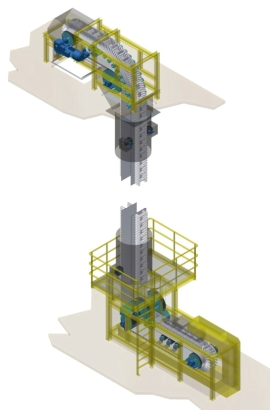Listed below are many of the common complaints related to Steep Angle Conveyor. We have tried to present them in order of probable occurrence. However, the list is by no means exhaustive. Many of the problems cited can be avoided by planned, preventive maintenance program, which ensures optimal performance and reduced downtime.
Below points to be taken care for Troubleshooting of Steep Angle Conveyor
1. Belt bowed. – Avoid telescoping belt rolls or storing in damp locations. A new belt should straighten out when ” broken in” or it must be replaced.
2. Belt improperly spliced or wrong fastener. – Use correct fasteners. Retighten after running for a short while. If improperly spliced, remove belt splice and make new splice. Set up regular inspection schedule.
3. Belt speed to fast. – Reduce belt speed.
4. Belt strained on one side. – Allow time for new belt to “break in”. If belt does not break in properly or is not new, remove strained section and splice in a new piece.
5. Breaker strip missing or inadequate. – When service is lost, install belt with proper breaker strip.
6. Take-up tension too high. – Recalculate tension required and adjust take up accordingly. Reduce take-up tension to point of slip, then tighten slightly.
7. Counterweight too light. – Recalculate weight required and adjust counterweight or screw take-up accordingly.
8. Damage by abrasives, acid, chemicals, heat, mildew, oil. – Use belt designed for specific condition. For abrasive materials working into cuts and between plies, make spot repairs with cold patch or with permanent repair patch. Seal metal fasteners or replace with vulcanised step splice. Enclose belt line for protection against rain, snow, or sun. Don’t over-lubricate idlers.
9. Drive underbelted. – Recalculate maximum belt tensions and select correct belt. If line is over-extended, consider using two-flight system with transfer point. If carcass is not rigid enough for load, install belt with proper flexibility when service is lost.
10. Edge worn or broken. – Remove badly worn or out-of-square section and splice in a new piece.
11. Excessive impact of material on belt or fasteners. – Use correctly designed chutes and baffles. Make vulcanised splices. Install loading idlers. Where possible, load fines first. Where material is trapped under skirts, adjust skirt boards to minimum clearance or install cushioning idlers to hold belt against skirts.
12. Excessive tension.– Recalculate and adjust tension. Use vulcanised splice within recommended limits.
13. Frozen idlers. – Free idlers. Lubricate. Improve maintenance. (Don’t over-lubricate)
14. Idlers or pulleys out-of-square with centre line of conveyor. – Realign. Install limit switches for greater safety.
15. Idlers improperly placed. – Relocate idlers or insert additional idlers spaced to support belt.
16. Improper loading, spillage. – Feed should be in direction of belt travel and at belt speed, centred on the belt. Control flow with feeders, chutes and skirt boards.
17. Improper storage or handling. – Refer to Steep Angle Conveyor for storage and handling tips.
18. Insufficient traction between belt and pulley. – Lag drive pulley. In wet conditions, use grooved lagging. Install correct cleaning devices for safety. See item 7, above.
19. Material between belt and pulley. – Use skirt boards properly. Remove accumulation. Improve maintenance.
20. Material build-up. – Remove accumulation. Install cleaning devices. Improve housekeeping.
21. Pulley lagging worn. – Replace worn pulley lagging. Use grooved lagging for wet conditions. Tighten loose and protruding bolts.
22. Pulleys too small. – Use larger diameter pulleys.
23. Relative loading velocity too high or too low. – Adjust chutes or correct belt speed. Consider use of loading idlers.
24. Side loading. – Load in direction of belt travel, in centre of conveyor.
25. Skirts improperly placed. – Install skirt boards so that they do not rub against belt.








